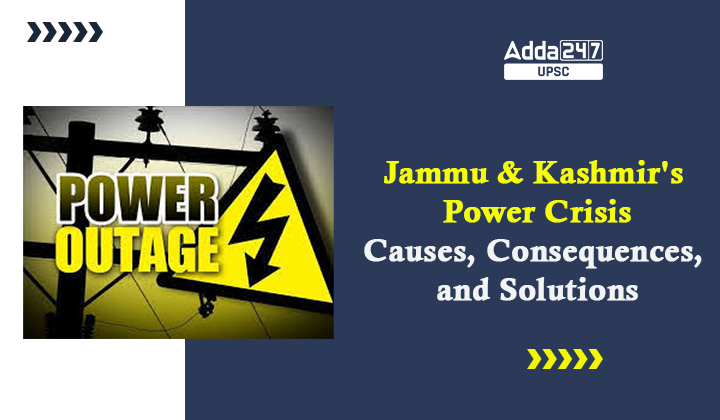Table of Contents
Jammu and Kashmir (J&K), a Union Territory in India, is currently grappling with a significant power crisis that is affecting both its residents and its economy. This crisis has emerged due to a combination of factors, including a reduction in power generation from hydroelectric projects, transmission losses, inadequate metering, and the rising cost of electricity procurement. In this article, we will explore the underlying causes of the power crisis, its consequences, and the steps that the J&K administration is taking to address this pressing issue.
Power deficiency in Jammu and Kashmir
Electricity Requirement vs. Generation
- J&K has a total electricity requirement of approximately 2,600 MW, with 1,200 MW needed for the Kashmir division and 900 MW for Jammu.
- However, the Union Territory currently faces a deficit of about 500 MW, which has been straining the region’s power supply.
Current power generation
- Despite having an identified power generation potential of 16,475 MW, J&K only generates 3,263 MW of electricity from 21 power projects.
- The central sector contributes 2,009 MW from seven projects, while the private sector adds around 42.5 MW through four projects.
- The majority of this power generation (over 85%) comes from hydropower projects, with the Baglihar project in the Chenab basin being the largest, boasting an installed capacity of 900 MW.
The Ongoing Power Crisis
Impact of Dry Spell
- One of the primary reasons for the power crisis in J&K is the dry spell experienced during the summer months, which led to a significant reduction in power generation across its hydroelectric projects.
- The dry spell resulted in decreased water flow in the region’s rivers, directly affecting the generation capacity of power projects. For instance, the Baglihar project’s total generation, which was approximately 1,050 MW, dropped to about 700 MW by the end of September and further decreased to 200–250 MW.
High Cost of Procured Electricity
- To mitigate the power deficit, J&K has been procuring additional electricity from the central power exchange.
- However, this purchase of electricity is comparatively expensive, with costs ranging from Rs 7 to Rs 10 per unit. In contrast, electricity is supplied to consumers at a subsidized rate of Rs 1.25 per unit for below-poverty-line consumers and a maximum of Rs 4.50 for regular consumers.
- This price differential is costing the exchequer significantly, amounting to Rs 750 crore monthly, which is expected to rise to Rs 850 crore per month during the peak winter season in Kashmir.
Transmission Losses
- J&K also experienced substantial transmission losses, with aggregated technical and commercial (AT&C) losses at 62% last year. While efforts are being made to reduce these losses to approximately 45% in the current financial year, challenges persist.
- One major issue is that only 50% of J&K has metering systems in place, making it difficult to bill consumers accurately. Additionally, electricity pilferage through the use of uninsulated wires exacerbates the transmission losses.
The Status of Metering in J&K
Metering Progress
- Out of the 21 lakh households in J&K, approximately 50% have metered connections. Additionally, smart meters have been installed in about 4 lakh households.
- However, the installation of meters has faced resistance in many parts of the Union Territory, both in rural and urban areas. The administration emphasizes that round-the-clock electricity can only be possible with 100% metering in all areas.
Differential power cuts
The administration has implemented a power curtailment schedule where metered areas experience power cuts of up to 4.5 hours a day, while non-metered areas face longer eight-hour power cuts. These hours of power cuts is expected to increase in the coming months.
Steps Taken by UT Administration
Promoting Metering
The J&K administration is aggressively promoting the installation of meters across the region. The focus is on achieving 100% metering to minimize power cuts and improve billing accuracy.
Using AD cables
To prevent theft and reduce transmission losses, the administration is encouraging the use of AD (aerial bundled) cables for insulating wiring. This step aims to address the problem of electricity pilferage through uninsulated wires.
Revamped Distribution Sector Scheme (RDSS)
- The Revamped Distribution Sector Scheme (RDSS) is a $5500 crore project that has received approval, with 90% of the funding coming from the Indian government and 10% from the Union Territory.
- The scheme includes measures like metering, AD cables, and modern transformers to improve power distribution and reduce transmission losses.
- The goal is to bring transmission losses under 20% through structural reforms.
Green Energy Corridor (GEC) Phase-II
- The union cabinet has approved the Green Energy Corridor (GEC) Phase-II, involving the Inter-State Transmission System (ISTS), for a 13-GW renewable energy project in Ladakh.
- This project aims to integrate Ladakh’s power grid with the National Grid, which will help in supplying power to J&K. Additionally, this project will reduce J&K’s reliance on hydropower, which is significantly reduced during the winter season.
Conclusion
Jammu and Kashmir’s power crisis is a multifaceted challenge that results from a combination of factors, including reduced power generation due to a dry spell, transmission losses, inadequate metering, and the high cost of procured electricity.
The UT administration is actively working to address these issues through measures such as promoting metering, using AD cables to prevent theft, and investing in infrastructure upgrades.
The implementation of the Green Energy Corridor Phase II is also a significant step toward ensuring a stable and reliable power supply for the region. As these initiatives take root, J&K can look forward to an improved power supply and a boost to its overall development.



 TSPSC Group 1 Question Paper 2024, Downl...
TSPSC Group 1 Question Paper 2024, Downl...
 TSPSC Group 1 Answer key 2024 Out, Downl...
TSPSC Group 1 Answer key 2024 Out, Downl...
 UPSC Prelims 2024 Question Paper, Downlo...
UPSC Prelims 2024 Question Paper, Downlo...





